Yellow Lantana, with its sunny disposition and vibrant blooms, stands as a beacon of cheerfulness in gardens around the world. This variety of lantana, known for its bright yellow flowers, adds a burst of color and warmth to any landscape.
Whether cascading from hanging baskets, bordering flower beds, or gracing patio containers, Yellow Lantana captivates with its radiant hues and delicate beauty.
Different Types of Yellow Lantana Flowers
Chapel Hill Yellow Lantana
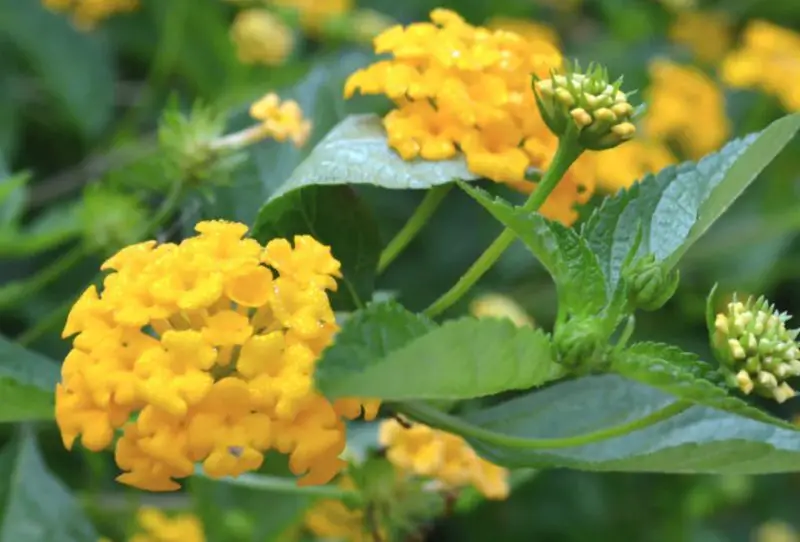
The Chapel Hill Yellow lantana stands out as a resilient choice among lantana varieties, growing compactly to 1 to 2 feet in height and sprawling gracefully to 3 to 4 feet in width. Its lush dark green foliage provides an enchanting backdrop for the vivid yellow blooms, exuding a delightful fragrance.
Thriving in loamy, well-drained soil, it withstands insects, drought, disease, and heat effortlessly, making it an excellent option for novice gardeners.
Hybrid Lantana
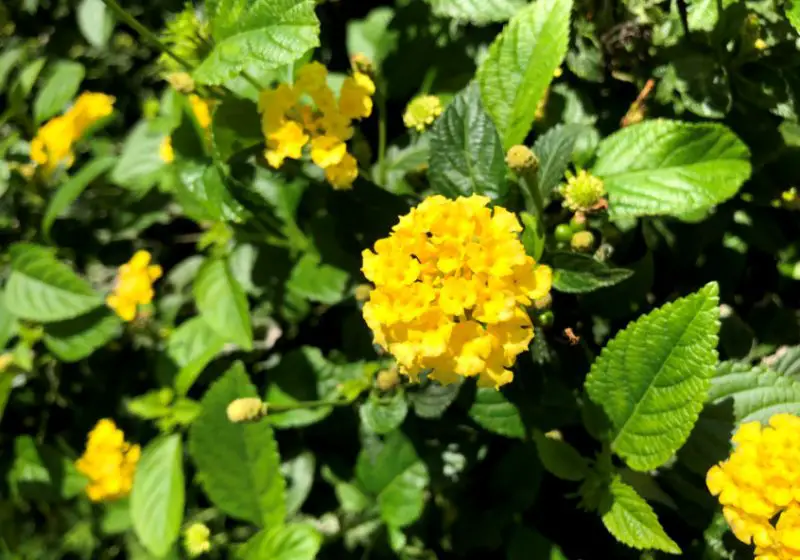
Hybrid lantana is a marvel of nature, unfurling its beauty across long seasons, particularly in the warmth of summer. Thriving in partial shade yet truly flourishing under the full blaze of the sun, this hybrid variety embodies the best traits of its lantana ancestors.
From longer leaves with minimal spikes to those adorned with vibrant blooms, hybrids display a diverse array of characteristics. With selections spanning a spectrum of colors, these plants bring a kaleidoscope of hues to any garden.
Pineland Lantana
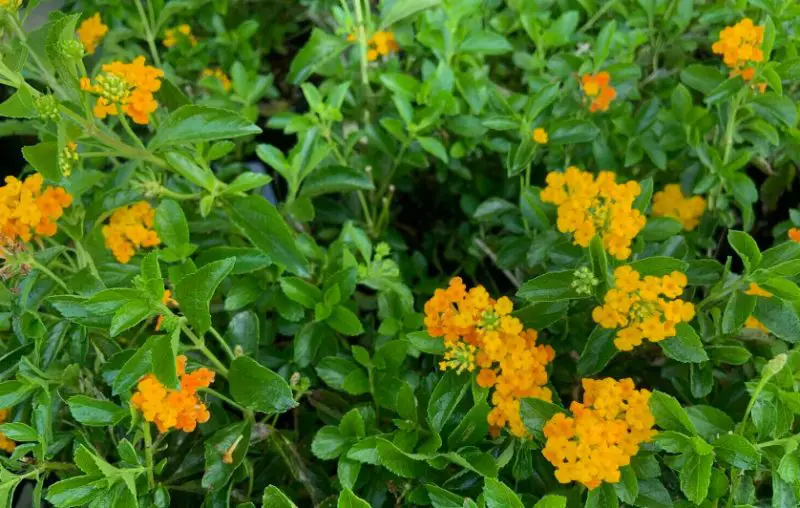
Pineland lantana, indigenous to South Florida, offers several benefits for your typical flower bed. With a shorter stature, it’s ideal for maintaining lower beds, such as those around mailboxes. Its vibrant yellow flowers possess an irresistible allure for butterflies, enhancing the garden’s beauty.
These trailing plants require occasional maintenance to contain their horizontal growth. However, their drought-resistant nature makes them easy to manage with sporadic watering. Whether adorning landscape islands, decks, or pool areas, Pineland lantana adds a touch of natural beauty to any outdoor space.
New Gold Lantana
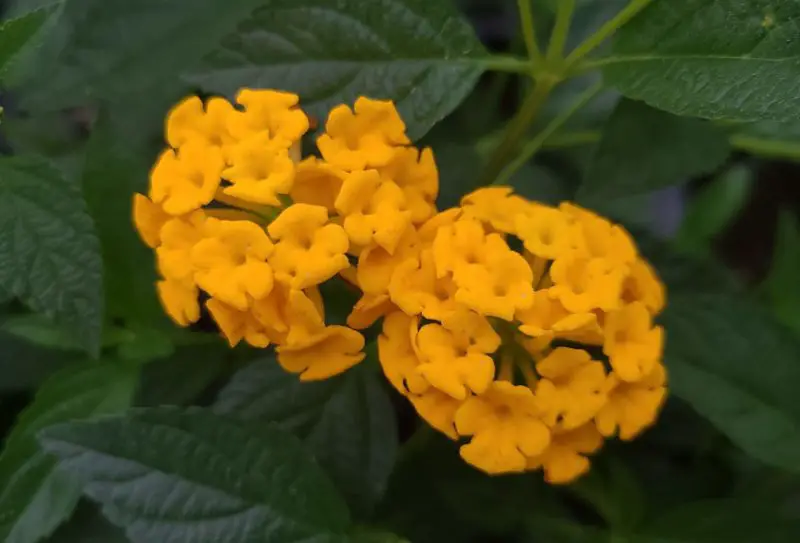
New Gold Lantana, a product of crossbreeding Montevidensis and Lantana Camara, boasts a low, mounding form, making it an excellent ground cover option. Versatile in its application, it thrives both indoors and outdoors, gracing gardens and yards alike.
Unlike its counterparts, New Gold Lantana exhibits greater resilience to cold temperatures. To cultivate this plant successfully, provide consistently moist soil and ample sunlight or partial shade.
With a blooming season that spans the entire year, this variety promises a continuous display of its stunning golden flowers.
Lantana Camara
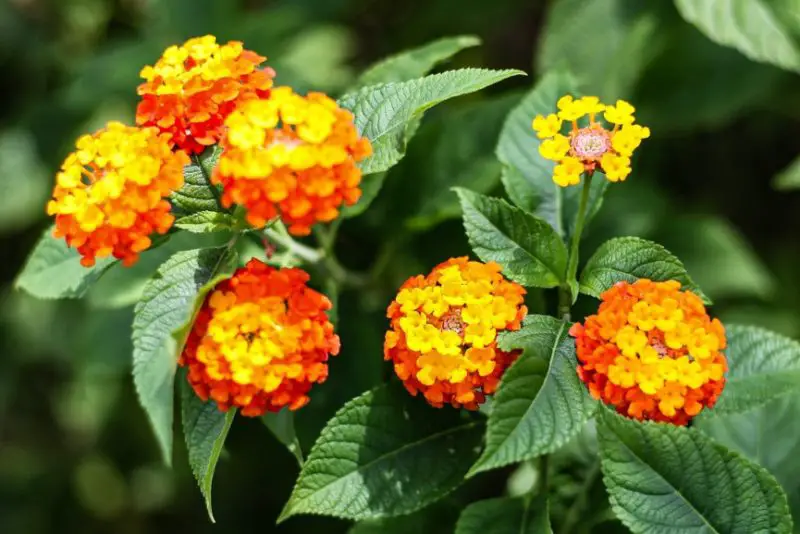
Lantana Camara varieties offer an impressive height, reaching up to ten feet in a graceful arching or half-sphere shape. As they grow dense with numerous branches spawning from the trunk, occasional thinning may be necessary. With a climbing habit, they can intertwine with other plants, requiring vigilant monitoring.
These vibrant shrubs produce a plethora of colors, including purple, pink, yellow, white, and red flowers. Found naturally in savannas, pastures, and forest edges, they thrive in disturbed landscapes like fence lines. When paired with purple violets, their beauty is truly breathtaking.
Lucky Pot of Gold Lantana
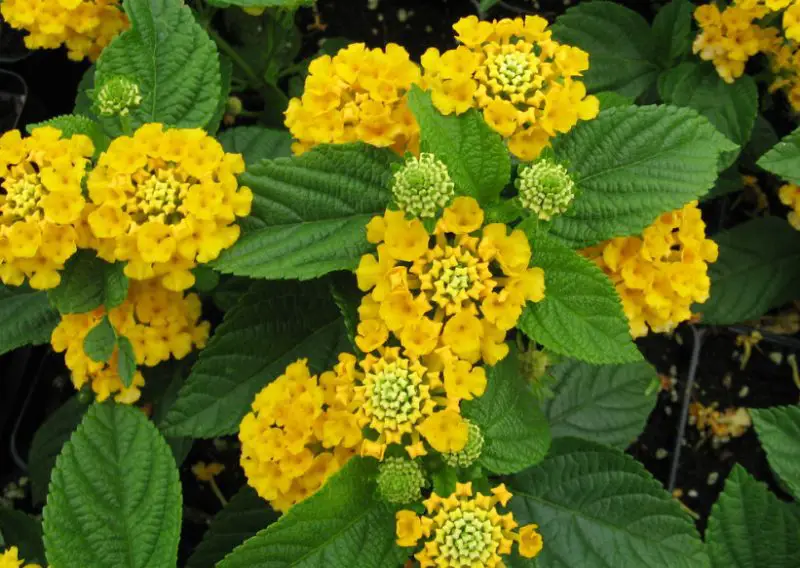
Lucky Pot of Gold Lantana is a stunning variety with vibrant yellow blooms. With a modest height of 10-14 inches, it’s well-suited for both ground planting and hanging baskets. Whether cascading from a pot or adorning a flower bed, its cheerful blossoms bring joy and beauty to any space. Easy to care for and visually striking, Lucky Pot of Gold Lantana is a delightful addition to any garden or landscape.
Mountain Lantana
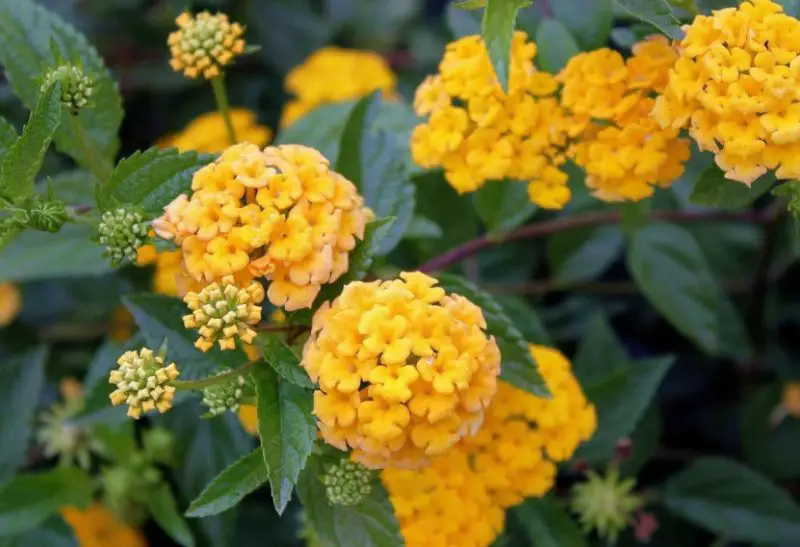
A common kind of flowering plants, the mountain lantana features big glossy leaves with blooms that are pink, yellow, and reddish in color. Its leaves, interestingly, change to yellow in the fall.
Requiring minimal care during full bloom, Mountain Lantana thrives with light fertilization every two weeks until spring. Unlike other lantana varieties, it tolerates dry climates well and doesn’t demand regular watering, relying instead on natural rainfall.
Pairing beautifully with purple asters, Mountain Lantana creates a strikingly contrasting flowerbed that captivates with its vibrant colors.
Bandana Yellow Lantana

Bandana Yellow Lantana stands out for its remarkable heat tolerance, thriving even in adverse weather conditions. Renowned for its diverse array of colored flowers—from black and brown to blue, yellow, cream, lavender, red, and white—it adds a vibrant splash to any landscape.
Adaptable to humid environments, it’s a popular choice near pools and hot tubs. With its expansive coverage, it’s ideal for gardening projects. However, its vigorous spreading nature requires caution; regular maintenance and herbicides may be necessary to prevent it from overpowering surrounding plants and becoming difficult to manage.
Lantana Radiation

Lantana Radiation stands as a top choice for border plants, effortlessly stealing the spotlight with its vibrant blooms. Thriving in hot climates, it requires minimal maintenance and is exceptionally drought-tolerant, eliminating the need for excessive watering.
During the initial growing season, regular watering is recommended to promote healthy root establishment. However, once established, it thrives without frequent watering. Over-fertilization should be avoided at all costs, as it can lead to root rot.
Dwarf Lantana
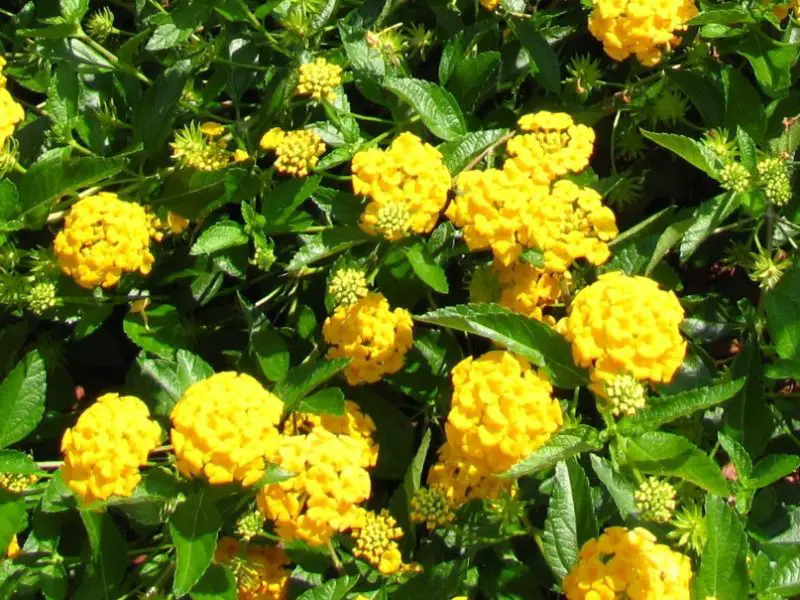
Dwarf lantanas are popular choices for patios, window ledges, and small balconies, thanks to their compact size and easy maintenance. Cultivated in small containers like boxes, tubs, and hanging baskets, they efficiently utilize limited space.
Their dwarf nature ensures they won’t overgrow or encroach on surroundings. Maintenance is straightforward; consistent watering keeps them healthy, while periodic fertilization every month or two promotes robust flower blooms.
Pumpkin Patch Lantana

Pumpkin Patch Lantana boasts orangish flowers reminiscent of pumpkins, complemented by greenish-yellow leaves. Thriving in moist environments, it requires consistently moist soil for optimal growth.
Direct sunlight is essential for its continued development and flower production. In colder temperatures, maintaining the plant at around 50°F prevents damage.
Watering once a week is sufficient; avoid overwatering. Ideal placement for Pumpkin Patch Lantana is in areas with ample sunlight exposure, ensuring its vibrant blooms continue to grace the garden.
Tropical Lantana
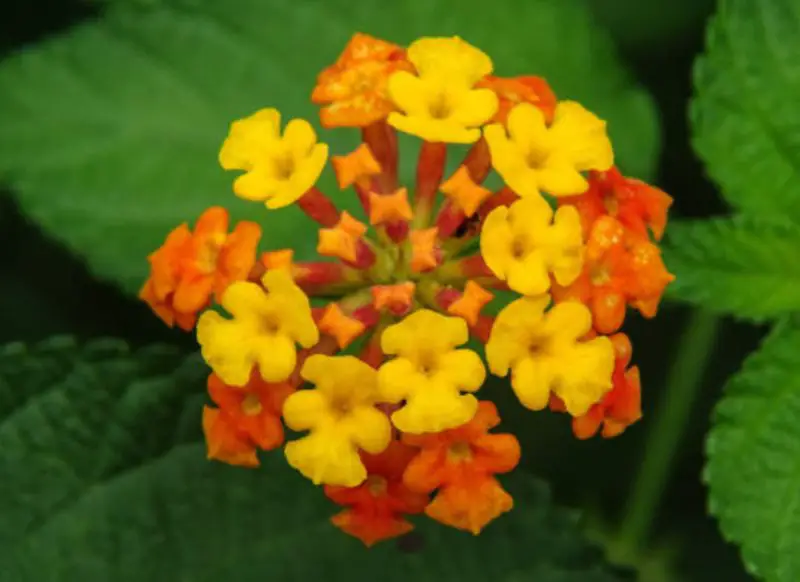
Tropical Lantana, also referred to as crimson lantana, bursts into vibrant blooms during late summer, boasting crimson red flowers clustered together. Its color palette extends from salmon pink to yellow and even purple in certain instances. Additionally, this lantana species yields red berries, providing sustenance for birds while deterring mammals.
Thriving in full sun, it tolerates shade but flourishes best under direct sunlight, requiring minimal watering for maintenance. Resilient to hot climates, it demands little attention once established. When paired with colorful camellias, Tropical Lantana creates a truly special garden display.
Prairie Lantana
Prairie Lantana, a native of North American grasslands, differs from typical lantana varieties in its growth pattern. Rather than blooming flowers, it spreads through underground stems, producing runners. However, when planted alongside flowering companions, it may occasionally yield blooms.
Thriving in moist soil and full sunlight, Prairie Lantana exhibits remarkable resilience, enduring even cold winds. Despite its unconventional flowering habits, its ability to adapt to various conditions makes it a valuable addition to gardens, particularly those seeking hardy, native plants.
Texas Lantana
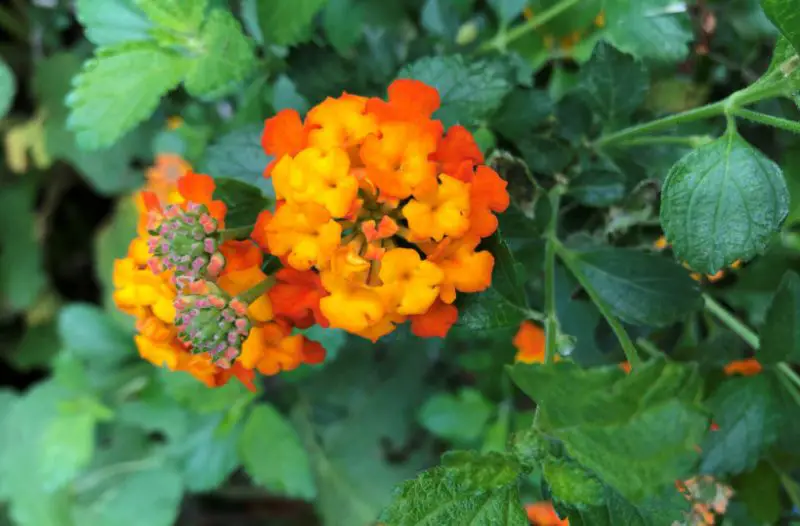
Texas Lantana, scientifically known as Lantana urticoides, is a beloved plant recognized by various names including calico bush and West Indian shrub verbena. Its striking blooms feature vibrant shades of red, yellow, and orange, adding a splash of color to gardens and landscapes. As a native of Texas and other southern regions, Texas Lantana thrives in warm climates and is cherished for its resilience and stunning floral display.
People Who Read This Also Read:






